|
PONDERING
THE FUTURE
I
was at the PCW show for only one trade day, so I didn't
get a chance to meet any readers of the column. But,
I did do the rounds of the strategy-producing software
houses to see if anything exciting was in the offing,
and one thing that struck me was that the Americans
were there in force. That's not surprising when we're
told that strategy games enjoy far more popular support
and rake in much more money in America, and I hesitate
to condemn it as a bad thing as American strategy games
are usually pretty good. The voluble and enthusiastic
presence of the American strategy promoters certainly
contrasted with the invisibility of British based companies.
There are, of course, a few dedicated British strategy
publishers whose commitment I don't doubt, but what
worried me was the fact that software houses who have
been known to offer the odd strategically orientated
game really didn't seem to be interested in promoting
anything for the future. The Commodore disk owner is
probably assured of a steady supply of high-quality
American games, but these are notoriously expensive
and those who can't afford them, or a disk drive, are
left to pick up the crumbs.
We
use the word 'strategic' in a loose way when it's a
label to distinguish games in the genre, but applied
to the theory of warfare it's a technical term which
means only one level of action in a pyramid of five.
Wargames
tend to operate on one or two of these levels. 'Politics'
is defined as the determination of a country's foreign
policy. There are few wargames which actually give the
player a choice about whether the country is going to
war, presumably because if he decided not to, there
would be no game to play! But there are games which
attempt to simulate world management, like Armageddon
Man.
'Grand
Strategy' is the formulation of war aims and policy,
and the creation and maintenance of alliances. Alliances
tend not to come into solitaire computer games, but
board games which simulate entire wars and involve more
than two players certainly do. 'Strategy' itself is
the planning of the campaign economically and effectively
to achieve the grand strategic aims. This is often simulated
by the resource-spending screens in wargames, when the
player is asked to dish out so many supply points and
so many points of air support.
'Grand
tactics' brings us to the actual deployment and movement
of forces on the field of battle, and it is on this
level where most war-games find their main area of play.
The level of most detail is 'tactics', and this is simulated
in games which recreate a single battle. 'Tactics' is
the management of small forces in the field, down to
the handling of weapons by individual soldiers. Thus,
'machine simulation' wargames can be said to be almost
purely tactical.
In
real welfare the responsibility for taking decisions
on each of the five levels would rest with different
people. Politicians, on the whole, decide what foreign
policy will be and whether or not to go to war; generals
take the strategic decisions in obedience to the grand
strategic objections worked out by the politicians,
lower-ranking officers make on-the-spot decisions about
the deployment of troops on the field, and the soldier
with the gun in his hand makes the ultimate decision
to fire. Computer wargames can and do put the player
in all these positions except the last, which might
in the end be the most important and the most problematic.
I wonder if there's a moral in this?
.
|
|
It
was Tsar Nicholai I who passed judgement on Napoleon's
failed attempt to invade Russia 'Russia has two generals
in whom she can confide -- General Janrier and Fevrier'.
It was a lesson of history which Hitler notoriously
chose to ignore when he mounted his own invasion in
World War II, and the Axis armies suffered heavy losses
in the futile struggle against the Russian winter. Over
four years, 60 million men fought on the Russian front.
According to the introduction in the rulebook of this
simulation of the campaign, 20 million of them were
casualties.
Looking
at the glossy package of this very traditional wargame
from the Australian company SSG, the purchaser is given
the immediate impression that this is a quality product
of some solidity. There's a 72 page rulebook, two shiny
full-colour card maps showing the entire area of play
with detailed terrain marking, four cards with tree
diagrams of the menus that drive the game, a strip of
printed labels to make your save game disk look neat,
and a form which entitles the first-time buyer to a
complimentary copy of the house magazine 'Run 5'. All
of this naturally made me expect that when I loaded
the game itself I would find something that looked like
it had been programmed in somebody's lunch break and
took twenty minutes to process the computer's turn.
I was pleasantly surprised. On-screen, Russia looks
like a traditional wargame, which tries to convince
the player that army divisions are rectangular and the
speed of computer movement is wonderous.

The
map for Russia is displayed in all its glory
These
are the aesthetics. The game itself aims to recreate
the entire four-year Axis campaign against. the Russians,
starting in 1941 and lasting for 48 month-long turns.
To ease the baffled player into this feat of wargaming
endurance, there are three shorter scenarios which,
in the usual nature of these games, concentrate on smaller,
specific battles. The three smaller scenarios allow
you to take control of a particular army 'group', North,
Centre or South, fighting over a small portion of the
map. In the campaign scenario you have control of the
whole army and the freedom of much of eastern Europe.
The
game is driven by a series of branching menus, which
differ slightly between the scenarios and the campaign.
The designers were clearly worried that some players
might get lost amid the trees, and so diagrams are provided
for startup, game designing, and playing. To give some
idea of the system's complexity, there are eighteen
menus associated with playing a scenario. This is a
headache to get to grips with at first, but I found
that I familiarised myself with the order of play surprisingly
quickly. One chapter of the extensive rulebook takes
the player through the first turn of the Leningrad scenario
step-by-step, and although this took me about three
quarters of an hour to work through, I was able to enter
subsequent turns in no time.
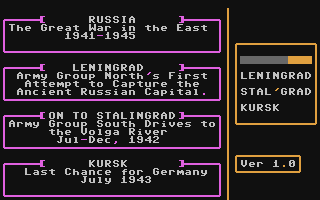
After
the usual preliminaries of choosing a difficulty level
-- you can opt for a minor, moderate or major advantage
to either side, which is worked out in terms of troop
numbers -- the player is launched straight into the
chosen scenario. The map in its entirety is divided
up into twelve sectors, and the scenario takes place
on three or four of them (one sector corresponds to
what fills a screen). Terrain is represented in an unobjectionable
sort of way, but the display is enhanced by the printed
map which comes with the package. It is useful too for
identifying cities. My one complaint about the screen
display -- and it's a fairly strong one -- is that cities
are not shown clearly enough. The whole of the gameplay
is centred around the pursuit and capture of cities,
and. it's very difficult to see them properly on the
screen. For some reason they have been drawn as a collection
of neutral grey blotches and blend into the scenery.
I would like to see large, solid red beacons!
The
units are shown as rectangles occupying a single hex.
There's a degree of limited intelligence, and you can
see more or less what type of troops your opponent has
-- whether they're tanks or infantry -- but only the
controlling player can see the specific classification.
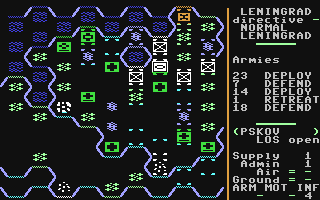
One
of the menus allows access to a number of information
screens, and you can call up displays onto the map showing
the communication value for the hexes, railways lines,
the controlling side of each hex, and what the map would
look like if it wasn't cluttered up with units. The
amount of information available for inspection is formidable
and, at first, rather alarming.
The
Axis army is divided into three army groups, which can
consist of up to six 'armees'. The armees can in turn
control six korps. There's a kind of command hierarchy
because this can be confusing at first, and the player
has to give orders at two different levels. An unusual
feature is that you don't actually tell units to go
to particular hexes, so you can't fight the enemy by
arranging your units in pretty patterns of your own
choosing. Each armee is given a general 'doctrine',
which determines what its aim will be. 'Main Effort'
is the signal for an offensive, and when this is chosen
the armee is targeted on a vicinity within seven hexes
-- less, in adverse weather conditions -- for the armee
headquarters. Thereafter, until the city is captured
or the armee's doctrine is changed, the korps units
attached to that armee move forward in an attempt to
reach and capture their objective. If enemy units get
in the way, they fight them. Their exact course is determined
by the computer and is not under the player's control
at all.
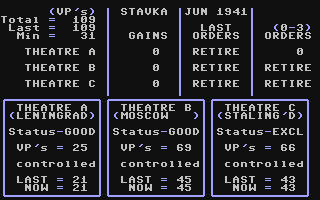
The
armee doctrine can be 'normal', in which case it does
little, but is still able to fight well, or it can be
ordered to rest, which enable the troops to recover
their strength quickly, but puts the korps at a disadvantage
if they're attacked.
Once
the armee doctrine has been selected, the player gives
orders to each individual unit or 'korps'. The range
of options open to the korps is determined by what the
armee doctrine is, and whether or not the unit is next
to an enemy unit. Next to the enemy, a korps whose armee
is on 'main effort' can assault, probe, defend or retreat,
and the player allocates ground support and air support
in points.
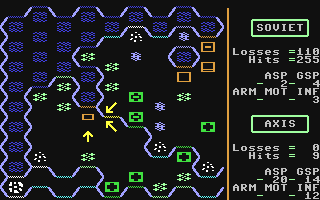
The
condition of each korps is given in a general way. Surprisingly,
there is no indication of exact numbers of men: the
state of the unit is described in terms of the troops'
combat experience and their fitness. Casualties are
given in the battle reports, but there seems to be no
way of referring back to this.
Each
armee has an individual supply of ground support units
which can be distributed to the korps, and the air supply
units come out of a general army group pool. If the
supply lines of a korps get cut off, they can't replenish
their OSPs, but their supply of ASPs is unaffected.
The provision of basic supply points is affected by
supply lines, too, and a novel statistic is the 'administration'
factor. This is an indication of how organised and ready
for combat a korps is. According to the instructions,
the maximum value of seven means that 'all the forms
are filled out and the army camp barber has sharpened
his razor'! When the fighting starts, things gradually
become more disorganised. An armee can't launch into
'main effort' unless its administrations and supply
points are high enough, and low values make them vulnerable.
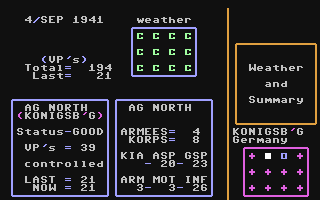
After
adjusting armee doctrines and giving individual korps
orders, the player wades back through the menus and
hits 'Run 5'. This command seems to be the SSG buzzword,
and executes the turn. Battles are resolved, and the
player's and the computer units move instantaneously
and simultaneously. No staring at the wallpaper -- it's
over in seconds!
|